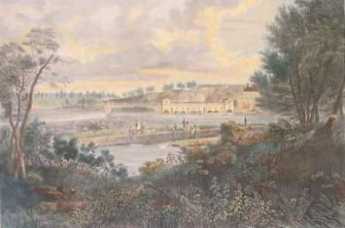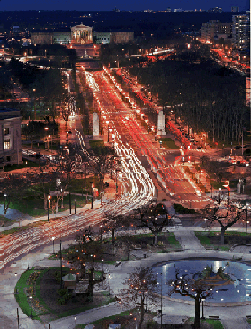Related Topics
Touring Philadelphia's Western Regions
Philadelpia County had two hundred farms in 1950, but is now thickly settled in all directions. Western regions along the Schuylkill are still spread out somewhat; with many historic estates.
The Main Line
Like all cities, Philadelphia is filling in and choking up with subdivisions and development, in all directions from the center. The last place to fill up is the Welsh Barony, a tip of which can be said to extend all the way in town to the Art Museum.
East Park Jingle
T he Paoli Local makes so many stops from 69th Street to Paoli, and those suburban stops look so much alike, that a dozing passenger can suddenly realize that he doesn't know whether he's gone past his intended stop or not. The conductor may shout out the station, but is it before, or after? To help with this problem, some wag composed a little jingle --"69 Old Maids Never Wed And Have Babies", which helps remember 69th street, Overbrook, Merion, Narberth, Wynnewood, Ardmore, Haverford, Bryn Mawr. There's more to the jingle for further stops, but it gets a little raunchy. And anyway, Bryn Mawr students get off at The College, so further stations are safely ignored.

|
| Fairmount Park |
In view of the success of the Main Line jingle, it is tempting to compose small doggerel to assist remembering the forty or so points of interest in Fairmount Park. The old Park Trolley line stopped running in 1946, so we must look further for a logical modern sequence. Marion W. Rivinus has provided an ideal model in her charming little book "Lights Along the Schuylkill", now unfortunately out of print. The charming book contains a succession of sketches and comments about the houses and history of Fairmount Park. The book kindly begins and ends with a map of the park, the locations all numbered, in a sequence which is a perfectly acceptable guide to a complete tour by today's roads. There are a dozen acceptable ways you might wander around the Park, but to see everything would take a week and so for anyone to follow Mrs. Rivinus' tour precisely is improbable anyway. Nevertheless, her numbered sequence, without ever saying so, is the suggested itinerary of someone who knows and loves the park better than anyone. Since several members of her family were members of the original Park Commission, she comes by it all by inheritance, She's very small, and very sprightly, quickly dominates any group who are visiting one of the Park Houses for a party, and has lots and lots to say. She surely will not be offended to have it generalized that her age is North of 80; if she wants to adjust that statistic further, you will have to ask her. Philadelphia really needs to have her book republished.

|
| Benjamin Franklin |
So, begin at the Art Museum with the portion of the park which is on the East side of the Schuylkill. The jingle we offer begins "An Eager Walker Brings Hot Chocolate" (Art Museum, Eakins Oval, Water Works, Boat House Row, Lemon Hill, Cliffs) for the visible and famous anchor of the Park, the culmination of the rather grand promenade of the Benjamin Franklin Parkway. Notice first the general lay of the land.

|
| City Hall |
The motorist driving West from City Hall starts to weave through traffic and then starts to careen around curves of the East River Drive, now called Kelly Drive. Absorbed in the intricacies of urban driving, the motorist often fails to look up to the right and notice that he is really driving past the end of an elevated plateau. The cliff end rises sharply enough that the modern commuter often does not realize how short a distance to the right it is to quite another world. The river makes two right-angle turns, with a large lake or reservoir along the top of the first point. The East Park Reservoir covers about twenty-five square blocks of land, with colonial-era houses along the river rim, and the very dense urban area stretching off on the other side of the reservoir. The western edge of the forty-five acres of Girard College comes pretty closes to the edge of the park. If you drive from the edge of the cliff overlooking the Schuylkill, around the reservoir, and then down the side wall of Girard College, it is quite a shock to go from 18th Century mansions, woods, and pastures suddenly into what cannot honestly be called anything but a slum. A huge teeming slum, that seems to stretch on, forever. But back at Laurel Hill on the western edge, you walk a few steps from the road to the front door; if you walk straight through to the back porch, it is only fifteen steps from a spectacular view of the wooded river valley, and the edge of a very steep cliff. Although the Randolph family lived here and gave it the current name, Laurel Hill was the country seat of the Rawle family, which also graces the name of the oldest law firm in the country.
The southern end of this central north-south ridge of Philadelphia is now called Lemon Hill. It was the site of William Penn's intended manor house, until he later relocated to Pennsbury, up near Trenton. In time 300 acres of the area became -- by way of Tench Francis -- the country home of Robert Morris, probably the richest man in America and masterful financier of the Revolution. There is little question The Hill became the most glamorous social center in America, with George Washington staying overnight many times, and Martha Washington becoming a firm fast friend of Robert Morris' wife Molly White Morris, sister of William White, first Episcopal Bishop in America. It's true there were real lemon trees on The Hills, also true the estate was sold at sheriff's sale when Morris got thrown into debtor's prison for three years. The cause of his financial collapse was not the Revolutionary War, but overzealous speculation in real estate in the District of Columbia when it was decided (against his loud objections) to move the Nation's capital to the swamps of the Potomac. Morris was a great patriot for his country and his city, but he was also a bold and reckless speculator. Eventually, it caught up with him. Since the loss of the Capital was the greatest defeat Philadelphia ever experienced, it could easily be supposed the judges of his bankruptcy were unsympathetic with his attempt to profit from the deal.
There is only a thin shelf of land, scarcely wide enough for the East River Drive, at the foot of the cliff from the Water Works to the Wissahickon Creek, so most of the interesting houses are up at the top of the ridge. It is all a driver can do to stay on the twisting road and notice Boat House Row, with skulls on the river, without looking up to the right to see what's interesting. Many of the houses, like Woodford of William Coleman (Ben Franklin's lawyer). Laurel Hill of Francis Rawle, Mount Pleasant that was almost sold to Benedict Arnold, the Thompson family's federalist mansion called Rockford, and Charles Thompson's Somerton, later acquired by Judge William Lewis and now called Strawberry Mansion, were homes of prominent leaders of the American Revolution. Other houses in the neighborhood belonged to Tories. The Franks of Woodford almost became Arnold's neighbors while David Franks was smuggling letters to Major Andre, Joseph Galloway was Provost Marshall of Philadelphia during the British occupation, so his home, Ormiston, was confiscated when he left town along with General Howe. Two houses were moved to the premises, sort of destroying the dream of the preservationists to have it just the way it once was. Although Hatfield House was built in 1760, it was originally on Hunting Park Avenue and moved, stone by stone, to Fairmount Park in 1930 at the expense of the Hatfield family. And finally, Grant's Cabin. It's really pretty interesting to see the two-room cabin where General and Mrs. Grant lived for five months, overlooking the James River while Grant was concluding his campaign that led to surrender at Appomattox, issuing orders to Sherman and Sheridan, and receiving the visits of Lincoln, Meade and the Confederate Commissioners suing for peace. It's highly interesting to have Grant's headquarters displayed in our park, but, well, it seems a little out of place if you know what place you are visiting.
Let's extend our little doggerel. It begins with "An Eager Walker Brings Hot Chocolate;" and goes on "Most real Olympic runners won't stop." That's Mount Pleasant, Rockland, Ormiston, Randolph, Woodford, and Strawberry Mansion.
Originally published: Wednesday, June 21, 2006; most-recently modified: Monday, May 20, 2019